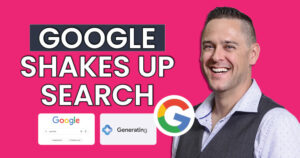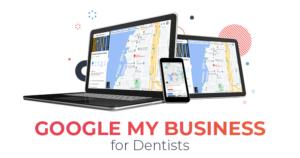How a Google Local Campaign Is a Quick Win for Your Dental Practice [VIDEO]
In this video, you’ll discover how a Google Local Campaign can increase your website’s local visibility (check out the case study in the video – one of our dentists saw an 1800% increase in searches on maps and an overall 683% search increase on the views of his listing!).
Watch the video or read the transcript below to learn more.
If you’re ready to add this campaign to your dental marketing strategy, give us a call!
Video transcript: Google local campaign overview
Hey, I just want to do a quick explanation on how the local campaign works specifically for Google ads.
This is separate or different from the normal expanded search ads or display or branding ads. This is specifically focused on promoting the visibility of your brick-and-mortar location – basically, a branded pin that shows up on Maps.
As you’re scrolling through your map section, you’ll be able to see your pin with your logo on it. Instead of just that red pin or dot that’s on there, you’ll start to show up here as a paid ad at the top of the map feature pack.
So if someone’s searching for any of the keywords that normally will trigger or show your Google profile business listing, you now have a much higher percentage chance to be able to show up in that map pack in both map searches, as well as search visibility on Google.
Just a quick showing of this:
This is for one of our clients that has tried it out. We did it both midway through last month, and he’s currently at about a $20 a day budget. On average, that’s the recommended budget for a local campaign.
However, depending on the size of your community, you might be able to go with a little bit less.
So you could go anywhere from $12 to $15/day as a starting point, which would put you right around $500 a month. If you’re in a really competitive area, then $20 is kind of your minimum and you can go up from there.
But just to show you what the potential return is on running a local campaign.
Now, keep in mind, this is separate from any kind of search campaign or paid ads campaign.
This is purely going to provide extra visibility for your business listing on Google. But if we look at this dashboard, we can see in December the raise of the map view.
Google local campaign case study results
So since he started running this campaign, he saw an 1800% increase in searches on maps and an overall 683% search increase on the views of his listing, as well as massive increases in people going to the website, requesting directions, etc. We’re expecting this to also jump in January as Google starts to get those conversion points.
And the campaign is actually optimizing for people calling his practice. So that also will start to rise up.
Those are the main key points that anybody is wanting when they’re looking at getting additional visibility to your practice:
- having people find you
- having people go to your website
- and having people phone on the practice.
What’s the ROI?
Now, just to give a quick overview of what kind of return you would expect to get off that. So if you’re spending $500 a month, let’s say just as a starting point, that’s the $12 to $15 a day range. I want to give kind of a low-level number so that you can see how realistic this is.
The target conversion rate is 10%. Meaning – how often does someone actually turn into a lead on the website after seeing your ads? So, 10%. 90% won’t do anything, but 10% will turn into leads.
The average patient value over a lifetime … for an orthodontic practice or Invisalign, the average treatment cost for Invisalign is around $5,000. It could be a little bit more depending on the complexity, but then, again, the average is going to be around $5,000. For an implant, same thing, about $5,000 for a single tooth implant. (Again, it can go a lot higher, but we’re using that as a baseline for a general patient.)
Just a general practitioner. If someone comes in twice a year for cleaning, they do nothing else, they accept no other treatment. They might refer one patient or one friend or family member to the practice over the period of their lifetime. And they stay with your practice anywhere from seven to nine years, which puts their normal value at around $9,000 to $10,000 over their lifetime.
So, what we’re doing is taking half of that and putting it as a patient value. So again, that $5,000 mark … it kind of works in any different situation.
The final thing we’re looking at is, of those leads, how many are really going to become customers? Well, let’s do 3-5%, 5% being on the high end 3% being on the low end.
We’re going to go on the low end just to show you the numbers.
That means, realistically, you can expect to receive 650 clicks on your ads, generating 20 leads for the practice, putting your cost per lead at just $10.
Now, if you were to close just two and that’s it. If you got two patients, then you’re really going to start expecting to generate a revenue of about $10,000 or overall or lifetime for that practice. That means your profit is at 1438% return on what you’re spending on your ads. Even if you only did half of that, even if you only closed one patient from these ads, you’re still pulling in over 700% return on the ad spend.
So if you have any questions or if you’d like to give it a try, there’s no long-term commitment on any of these local campaigns.
If you want to give it a try for even one to three months, please feel free to let me know. Thanks!



